With one of the largest forest systems out of all the states, it’s no surprise that there are many types of hawks in Michigan. In fact, there are at least eleven that are a regular sight, although more may pass through in their journey south.
Ready to learn more about the different types of hawks in Michigan? Keep reading!
Red-Tailed Hawk
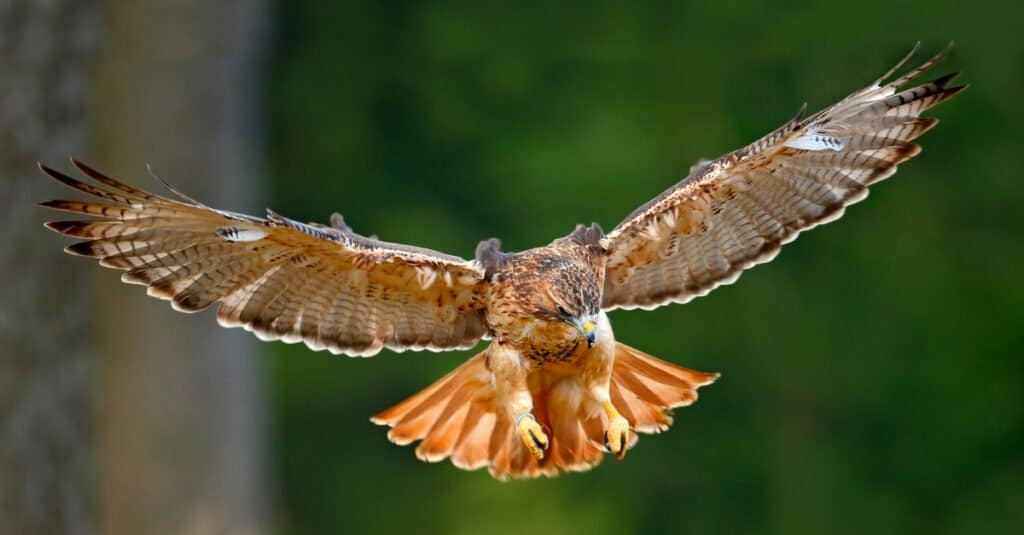
The red-tailed hawk’s distinct tail feathers are a result of the molting process.
©Ondrej Prosicky/Shutterstock.com
| Scientific Name | Buteo jamaicensis |
| Weight | 2.4 pounds |
| Height | 18 – 26 inches |
| Wingspan | 40.8 – 57.6 inches |
When it comes to hawks in Michigan, there’s almost no doubt that you’ve at least caught a glimpse of a red-tailed hawk. Red-tailed hawks are one of the most common types of hawks in the United States. In fact, there are very few states where you won’t find them, such as Hawaii or Alaska.
Although they do fly south for the winter like most other birds, their definition of the south is much different than ours! This means that they’re common even in northern states like Michigan during the colder months.
Based on size and appearance alone, the red-tailed hawk is easily mistaken for other types of hawks in Michigan. This includes the red-shouldered hawk, which is also on this list further below. The red-tailed hawk is a large bird of prey, larger than the red-shouldered hawk. It is best identified by its belly, which has a dark brown band.
However, this is just a glimpse at what the red-tailed hawk looks like. There are fourteen subspecies of red-tailed hawk in the world, with several being found right here in the United States. The most common red-tailed hawk, however, is the eastern red-tailed hawk (B. j. borealis). This is one of the most common types of hawks in Michigan.
Sharp-Shinned Hawk
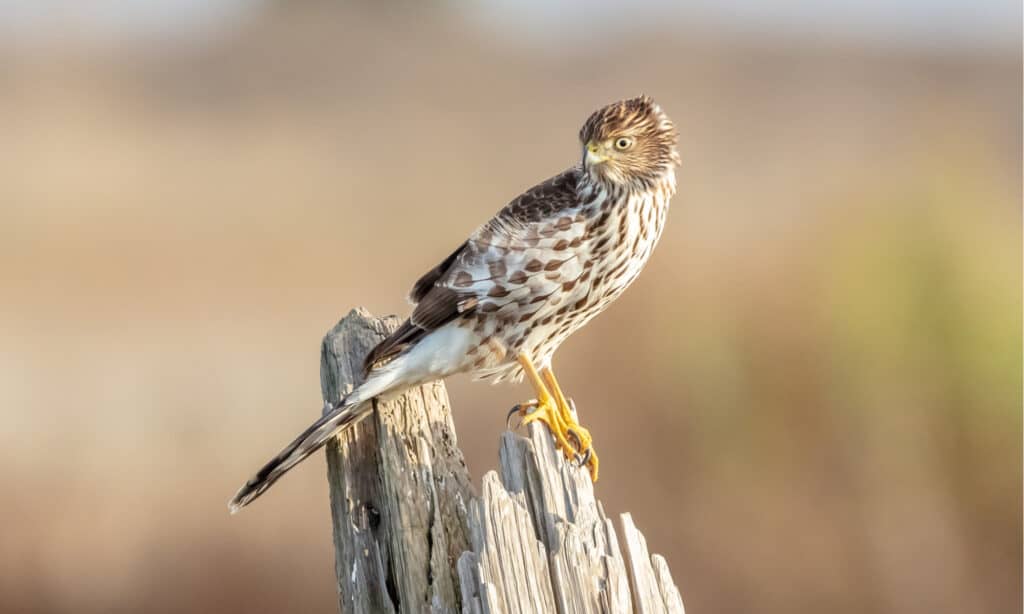
The sharp-shinned hawk is the smallest type of hawk.
©Pierre Leclerc/Shutterstock.com
| Scientific Name | Accipiter striatus |
| Weight | 2.9 – 7.7 ounces |
| Height | 9 to 15 inches |
| Wingspan | 17 to 26 inches |
When you look at other types of hawks in Michigan, you probably expect them all to be similar to the red-tailed hawk. After all, with its large body and wingspan, the red-tailed hawk seems like the typical hawk. However, the sharp-shinned hawk likes to turn these expectations upside down.
You see, sharp-shinned hawks are the smallest types of hawks in Michigan. Actually, they’re the smallest hawks in all of the United States. However, despite their compact size, they are still expert predators.
When you’re a large hawk like other types on this list, you’ll have to rely more on speed and strength to catch prey. However, sharp-shinned hawks can be a little sneaky. Found mostly in the forests of Michigan, they like to hide in bushes and ambush other small birds. The sharp-shinned hawk also likes to hunt around bird feeders in suburban and rural areas, where smaller birds are more likely to be. However, when no small birds are available, this hawk will also eat rodents, reptiles, amphibians, and even bats.
There are around 10 subspecies of sharp-shinned hawk in North and South America. The ones found in Central and South America, such as in Mexico, tend to be larger than those found in the United States.
Rough-legged Hawk
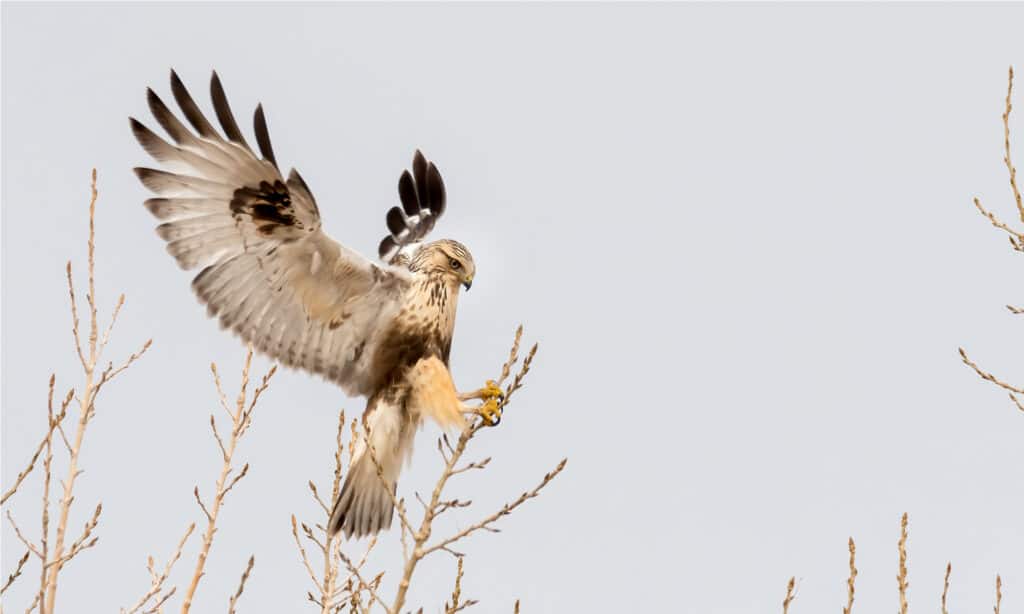
The rough-legged hawk is known for its feathered legs.
©Eivor Kuchta/Shutterstock.com
| Scientific Name | Buteo lagopus |
| Weight | 2.2 pounds |
| Height | 18 – 23 inches |
| Wingspan | Around 52 inches |
Remember how some birds have a different definition of flying south for the winter? The rough-legged hawk is one of the best examples of that!
Rough-legged hawks are designed to endure some of the coldest temperatures. In fact, they’re only found in the Arctic and Subarctic regions of North America, Europe, and Russia during the summer. Here, they spend their time hunting their choice of prey, from smaller birds to mammals. Because food can be scarce in these areas at times, they’re not the pickiest of eaters.
When winter comes, however, that’s when you’re likely to see this type of hawk in Michigan. As the temperatures begin to drop, the rough-legged hawk will make its way from the Arctic zones up north to settle in the United States and Europe.
Being from such a harsh environment makes rough-legged hawks a bit different from the hawks you’ll regularly see in Michigan. They have a much larger size for one. They also have feathered legs, which are only found on two other hawk species in the United States: the ferruginous hawk and the golden eagle.
Another unique fact about rough-legged hawks is that they are one of the few predatory birds that have the ability to hover. Other birds with this ability include kestrels, kites, and osprey. Like certain types of osprey, the rough-legged hawk can hover in a single spot by quickly beating its wings.
Cooper’s Hawk

Because of their dark bodies and light bellies, Cooper’s hawks are often mistaken for other types of hawks in Michigan.
©Richard G Smith/Shutterstock.com
| Scientific Name | Accipiter cooperii |
| Weight | 1.2 pounds |
| Height | 14 – 20 inches |
| Wingspan | 29 – 37 inches |
Cooper’s hawks are average-sized hawks with a diverse diet of up to 300 species. They have an equally diverse variety of names, including big blue darter, chicken hawk, flying cross, hen hawk, quail hawk, striker, and swift hawk.
Cooper’s hawk actually gets its name from a certain scientist, William Cooper. However, William Cooper wasn’t the one to name this type of hawk in Michigan. Instead, Cooper’s hawk was named by Charles Bonaparte in 1828. Bonaparte named the hawk after William Cooper because of his contribution to gathering the specimen.
Broad-Winged Hawk
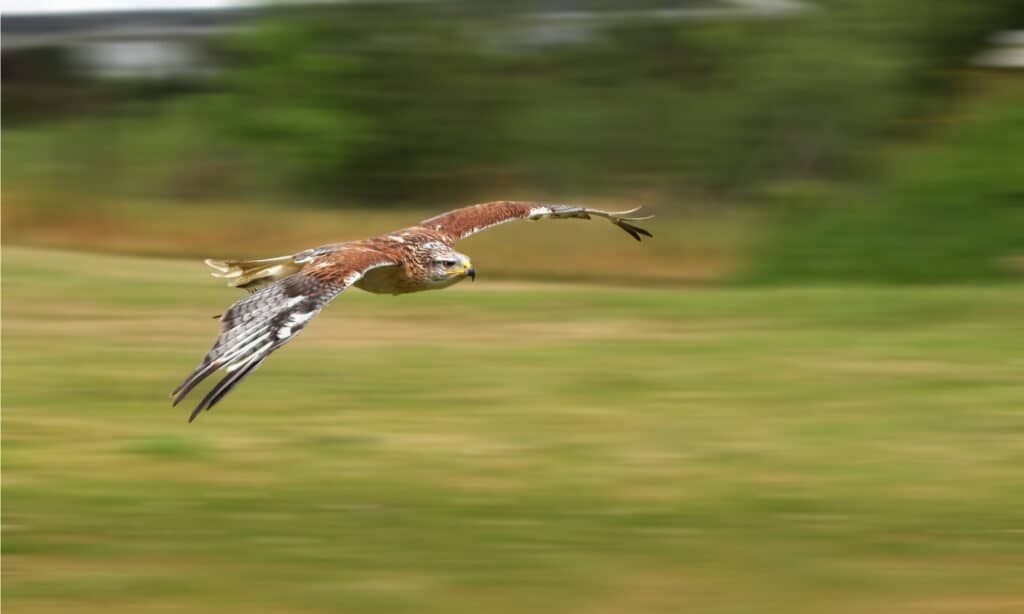
The broad-winged hawk is the smallest in its family.
©pr2is/Shutterstock.com
| Scientific Name | Buteo platypterus |
| Weight | Around 1 pound |
| Height | Around 34 inches |
| Wingspan | Around 16 inches |
You can find the broad-winged hawk in almost every location in eastern North America during the warmer months of the year. However, as winter approaches and the temperatures drop, the broad-winged hawk will move south, like many other types of hawks in Michigan will do. The broad-winged hawk spends its winter vacation in an area known as the Neotropics, which ranges from Mexico to southern Brazil.
Although the sharp-shinned hawk is considered the smallest hawk, broad-winged hawks are the smallest of the Buteo family. They’re best known for their dark bodies with white markings. Because there are almost two million broad-winged hawks in North America, they’re a common sight in warmer months.
Red-Shouldered Hawk
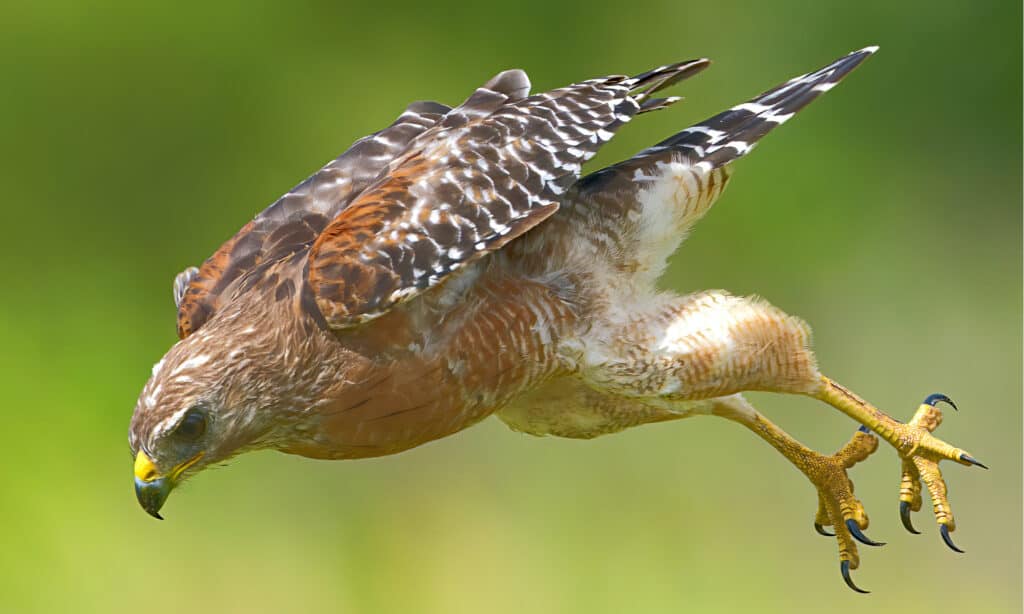
The red-shouldered hawk is an expert hunter, making it a great addition to falconry.
©Chase D’animulls/Shutterstock.com
| Scientific Name | Buteo lineatus |
| Weight | 1.3 pounds |
| Height | 15 –19 inches |
| Wingspan | 37– 42 inches |
Like other types of hawks in Michigan, red-shouldered hawks are important birds of prey in hunting. They can be tamed and used in a type of hunting known as falconry. With falconry, hawks and other birds are taught to hunt down small mammals, like rabbits, and return them to their trainers.
Red-shouldered hawks are easily confused with red-tailed hawks. This is because they have similar names and appearances, and they also tend to live in the same areas. However, red-shouldered hawks are smaller than red-tailed hawks. They also have a unique pattern on their belly, with white and rust markings compared to the red-tailed hawk’s dark band.
Northern Harrier

The northern harrier is known for its owl-like face.
©Harry Collins Photography/Shutterstock.com
| Scientific Name | Circus hudsonius |
| Weight | 0.6 to 1.6 pounds |
| Height | 16 to 20 inches |
| Wingspan | 38 to 48 inches |
Because northern harriers thrive in milder climates, they’re a common type of hawk in Michigan. However, while they do spend most of the earlier months of the year in the northern region of the United States, they do travel further south in the winter. Typically, during this time, you can find them in the southern states such as Florida.
If you were to take a good look at northern harriers, you might not be able to tell that they’re hawks. Instead, you may mistake them for another type of bird of prey: an owl! This is because they have a unique flat face that helps them listen out for prey.
Unlike many other types of hawks, the northern harrier also displays what is known as sexual dimorphism. This means that males and females look different. Male northern harriers are gray with light markings, while females are brown.
Swainson’s Hawk
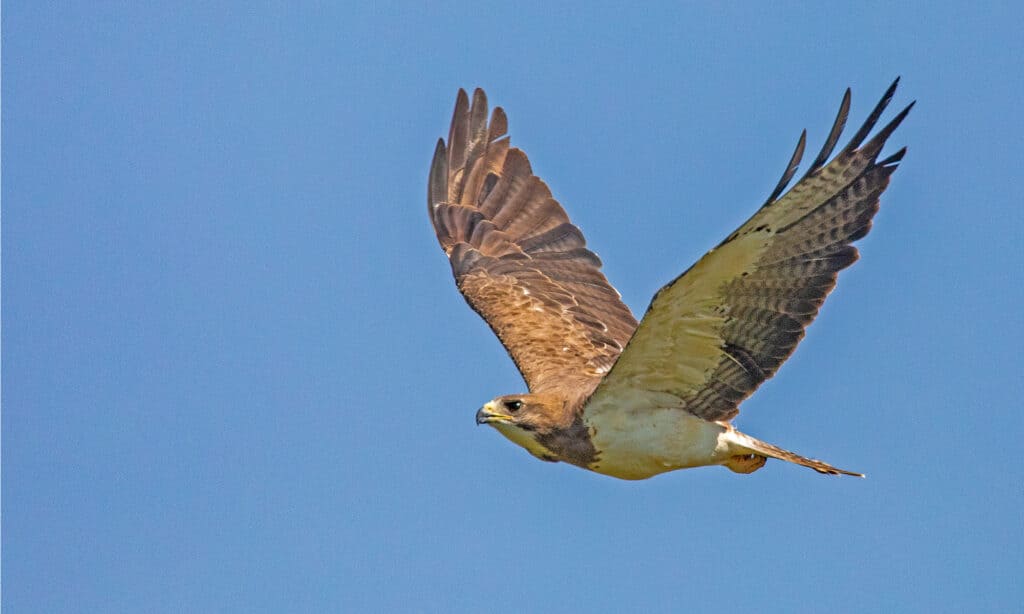
The Swainson’s hawk has a white belly with virtually no markings, making it easy to identify.
©Lowell Monke/Shutterstock.com
| Scientific Name | Buteo swainsoni |
| Weight | 1.8 – 2.5 pounds |
| Height | 18 – 22 inches |
| Wingspan | Around 49 inches |
Most hawks aren’t picky, and while Swainson’s hawks are no exception, they do have a favorite food. Swainson’s hawks will eat anything from mammals like rabbits to reptiles. However, their favorite food is grasshoppers. They will eat grasshoppers whenever they are available, which has earned them the nicknames grasshopper hawk and locust hawk.
Although they are one of the many types of hawks in Michigan, they’re not here for the entire year. Instead, they travel south for the winter, going deep into South America. Some travel all the way to Argentina! As a result, they are the raptor that migrates the longest distance each year.
Compared to other hawks, Swainson’s hawks are fairly large. They have dark bodies with rust-colored markings on their throats and chests. They’re a common sight in the Great Plains and throughout the rest of the United States. However, they’re much rarer in states like Hawaii and Alaska.
Northern Goshawk
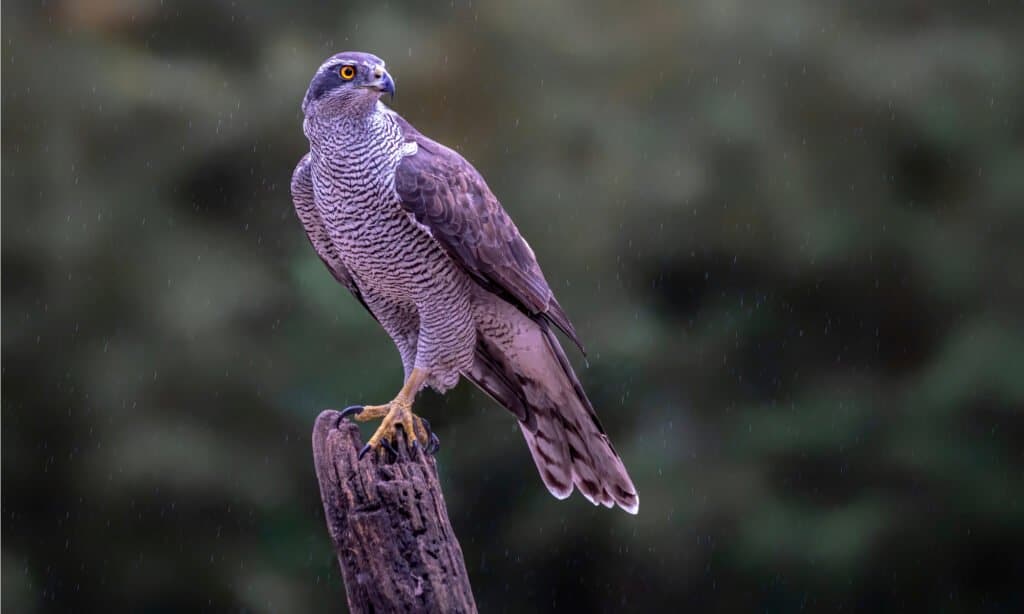
The northern goshawk is one of few hawks who display sexual dimorphism – different colorations between males and females.
©Albert Beukhof/Shutterstock.com
| Scientific Name | Accipiter gentilis |
| Weight | 1.5 – 3.25 pounds |
| Height | 18 – 27 inches |
| Wingspan | 40 – 47 inches |
As juveniles, northern goshawks can be difficult to identify. This is especially true when trying to tell the difference between the northern goshawk and the similar Cooper’s hawk. However, northern goshawks have a unique feature that sets them apart: eyebrows! While these don’t function like human eyebrows, these colored markings can help make it easy to tell who’s who in the bird world.
Northern goshawks are expert hunters. While they commonly eat mammals, reptiles, amphibians, and even insects, this isn’t their main diet. Instead, they’re known to eat mostly other birds! And not only small birds, either. The northern goshawk is even known for hunting and eating crows.
Ferruginous Hawk
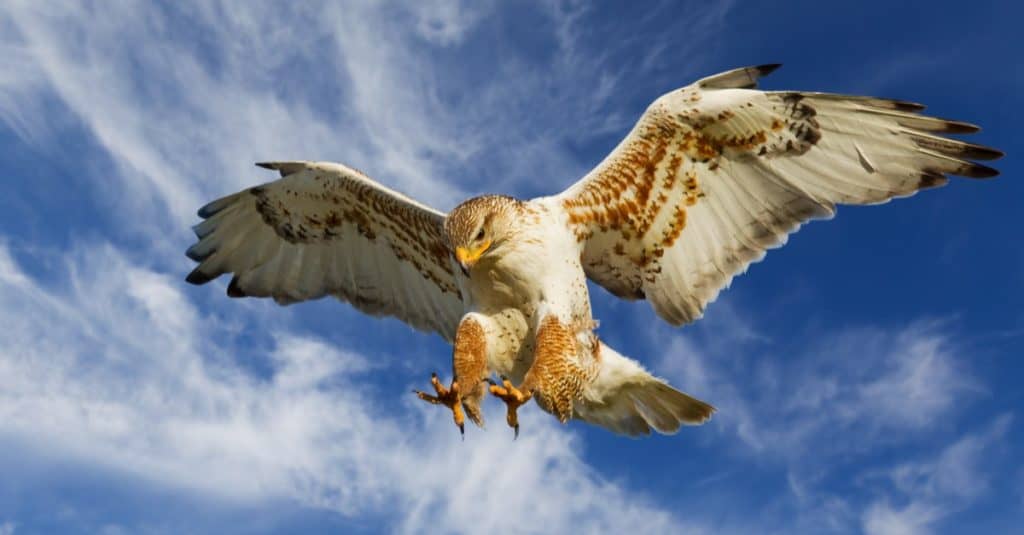
Like the rough-legged hawk, the ferruginous hawk has feathered legs.
©Stephen Mcsweeny/Shutterstock.com
| Scientific Name | Buteo regalis |
| Weight | 3.3 pounds |
| Height | Up to 27 inches |
| Wingspan | 53 – 56 inches |
Like the rough-legged hawk, ferruginous hawks are one of only three types of hawks with feathered legs. Because of this, they’re also known as the ferruginous rough-legged. However, it’s important not to mix these two species up, especially because they’re both types of hawks in Michigan.
If you haven’t heard of ferruginous hawks before, it may be because they’re a fairly rare species. This is due to their endangered status. Scientists had estimated that there are only around 4,000 breeding pairs left in the wild in the entire world. Conservation efforts have helped maintain the population, though.
The photo featured at the top of this post is © Stephen Mcsweeny/Shutterstock.com
Thank you for reading! Have some feedback for us? Contact the AZ Animals editorial team.






